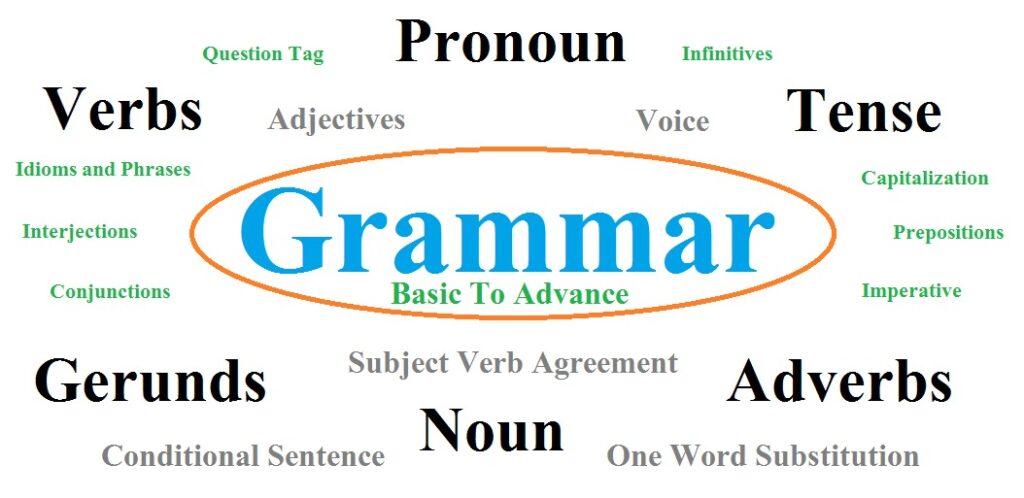
Tense | English Grammar Rules in Hindi
- Present indefinite tense ( S+v1+o) : इसका प्रयोग Habit या Regular क्रिया कलाप को show करता है जिन वाक्यों में निम्न शब्दों का प्रयोग किया गया हो Simple Present समझकर Simple Present की भाँती व्यवहार करेंगें | always, seldom, never, often, sometimes, usually, daily, everyone, usually, daily, everybody, every week, every month, every year, on monday, twice a month आदि
- Present Imperfect tense (s+is/am/are+V4+O) : Now, those days, still, at present, at this moment, continually, forever आदि शब्द Present Imperfect को show करता है इन शब्दों को देखते ही आप वाक्य को Present Imperfect की भांति व्यवहार करेंगें |
- Present Perfect tense (S+has / have + v3+o) : Already, yet, recently, so far, ever, several times, lately, up to now इसका प्रयोग Present Perfect समझकर Present Perfect में ही करें |
- Present Perfect Continuous tense : यदि वाक्य में समय सूचक word, e.g. childhood, marriage, death, arrival, departure, sunday, 1986, 17 september etc. रहे तो वाक्य Present Perfect Continuous में समझना |
- Past indefinite tense (S+V2+O) : Yesterday, lastnight, lastweek, last month, last year, ago इत्यादि का प्रयोग रहे तो उस Sentence के साथ Past Indefinite की तरह व्यवहार कीजिए |
- It is time, It is high time, It is right time, It is good time आदि के बाद हमेशा Past Indefinite किया जाता है |
- वर्त्तमान में Unfulfilled wish (नहीं पूर्ण होने वाली इच्छा) desire, condition को व्यक्त करने क लिए If, as if, as though, I wish etc. के बाद Past Indefinite का प्रयोग किया जाता है |
- 8. Past Imperfect tense (s+ was/ware+V4+O) : काल्पनिक वाक्यों में सभी Subject के साथ Were का प्रयोग होता है चाहें Were का प्रयोग healping Verb के रूप में हो या Main Verb के रूप में |
- I wish, I were a bird.
- He pretended as if he were sleeping.
9. Past Perfect tense : जब दो घटनाएं आगे-पीछे साथ घटित हुई हो तो पहले घटित हुई घटना के पहले Past Perfect tense एवं बाद वाले घटना के साथ simpal past का प्रयोग किया जाता है |
Before – इसका प्रयोग Past Perfect के बाद एवं Simpal past के पहले किया जाता है |
After – इसका प्रयोग Past Perfect के पहले एवं Simpal past के बाद किया जाता है |
10. Future Indefinite tense (S+shall / Will+V1+O) : Tomorrow, Next year, Next month, Next day, आदि रहे तो Simpal future के तरह व्यवहार करना चाहिए |
- For – जब समय की अवधि का उल्लेख हो या जब digit आता है तब ‘For’ का प्रयोग करें |
- For two hours, for last two year ( two, 2 digit)
- For five days, for last 2 months (five, 2 digit)
- For 10 years, for last 3 week (10, 3 digit)
- Since – जब शुरुआती समय का उल्लेख हो, तब since का प्रयोग करें |
- Since monday, since the beginning
- Since 2008, since time immemorial
- Since 7 P. M., since last year
- Since का प्रयोग – कैलेंडर, घड़ी, दिन के पहर एवं जीवन की अवस्थाओं के साथ ‘since’ का प्रयोग होता है –
Rule – 1
किसी वाक्य में Tense की पहचान की लिएहम निम्न को ही verb में शामिल करते है –
Tense में शामिल करेंगे
- Auxiliary Verb – is, are, am, was, were.
- Main Verb – run, teach, play, speak etc.
- Model Verb – can, may, might, should etc.
- Phrase(M.V.+Pre.) – give up, see off, go for, ask for etc.
Note –
यदि किसी वाक्य के बारे में यह पता करना हो कि वाक्य कौन से Tense है, Present/Past तो उपरोक्त Verb को पहचान के लिए शामिल करेंगे Common error बनाते समय आपको इस बात का ध्यान रखना है |
Rule – 2
किसी वाक्य में Tense की पहचान के लिए हम निम्न को शामिल नहीं करेंगे –
Tense में हामिल नहीं करेंगे
to+v1 में v1 को
pre.+v4(ing) में v4 को
has/have/had+v3 में v3 को
model+v1 में v1 को
He asked me(A) / What my name is (B) /and Where I came from ?(C)/ No Error(D).
Explanation
Part (A) में asked (V2) – Past Tense
Part (B) में is (Aux. V.) – Present Tense
Part (C) में came (V2) – Past Tense
आप जानते है कि एक वाक्य में एक ही Tense का प्रयोग करना है अत: Part(B) में is के बदले was होगा, क्योंकि यहाँ Past Tense की बहुलता है |
Note –
Tense से संबंधित error को choose करते समय दो ही बातों का ध्यान रखना है
- प्रारंभ में जिस Tense (Present/Past) का प्रयोग किया गया है, बाद में भी वही Tense आना चाहिए कोई दूसरा नहीं |
- यदि एक ही वाक्य में दो Tense (Present/Past) का प्रयोग किया गया हो, तो जिस Tense का प्रयोग अधिक हुआ है या जिस Tense का बहुमत ज्यादा प्रयोग किया गया है या हम कह सकते है, जिस Tense की प्रधानता है, अन्य जो दूसरे Tense में है को बदलकर एक कर लेना चाहिए और error के तौर पर कम वाले (संख्या से कम) को लेना चाहिए निम्नलिखित उदारण को देखिए –
(i) The celebrities showed childlike side yesterday (A) / as they all turn up wearing (B) / cartoon T-shirt for the promotion of (C) / their latest film in the city. (D) / No Error (E).
Explanation :
Part (A) में shiwed (V2) – Past Tense
Part (B) में turn (V1) – Present Tense
आप जानते है कि एक वाक्य में एक ही Tense का प्रयोग करना है लेकिन Part (B) में Turn लिखा है, जो V1 है, बोलें तो Present Tense जो error है, होना चाहिए था turned (V2).
(ii) The vicitim tried (A) / to all us (B) / what has happened (C) / but his woeds were not audible (D) / No Error (E).
Explanation : आप स्पष्ट रूप से देख रहे है कि –
Part (A) में Tried (V2) – Past Tense
Part (B) में has (V1) – Present Tense
Part (C) में were (V2) – Past Tense
यहाँ प्रधानता है Past Tense की, अत: has वाले part को error बोलेंगे सही करने के लिए has (V1) को बदलकर had(V2) करना होगा |
(iii) A dove perched on a near tree (A)/ sees the ant’s danger (B)/ and dropped a leaf into the water (C)/ No Error (D).
Part (A) में perched (V2) – Past Tense
Part (B) में sees (V5) – Present Tense
Part (C) में dropprd (V2) – Past Tense
यहाँ Past tense की प्रधानता है अत: सभी को Past में होना चाहिए मतलब ये हुआ कि Part (B) गलती (Error) है सही करने के लिए see का 2nd form saw करें

